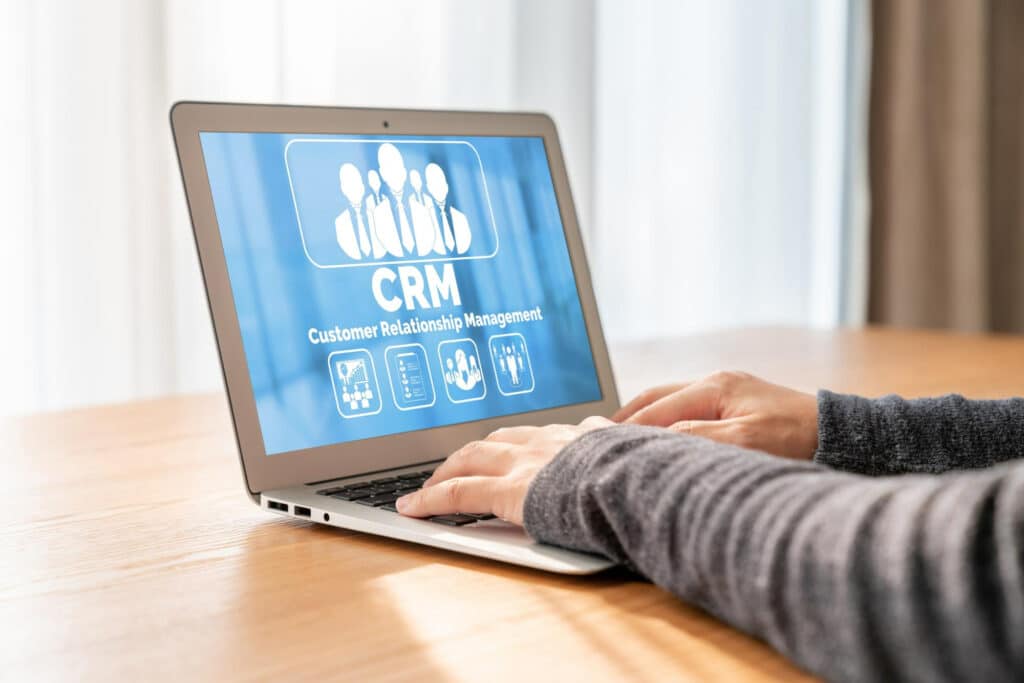To use a CRM effectively, focus on acquisition, engagement, personalization, and retention. Base your marketing strategy on these factors, and make sure to download the ebook for more information.
In today’s competitive business landscape, customer relationship management (CRM) has become a crucial tool for businesses to manage their interactions with customers effectively. But simply implementing a CRM system is not enough; it needs to be used effectively to harness its full potential.
This article will provide you with valuable insights on how to use a CRM effectively, helping you drive customer acquisition, engagement, personalization, and retention. By following these strategies, you can ensure that your CRM system becomes a powerful asset for your business, enabling you to build stronger and more profitable relationships with your customers. So, let’s dive in and discover the key practices for effectively utilizing a CRM system.
Understanding CRM and Its Benefits
Understanding CRM and its benefits
CRM, short for Customer Relationship Management, is a strategy that businesses use to manage interactions with customers and improve relationships. It involves using technology to organize, automate, and synchronize sales, marketing, customer service, and other activities. CRM is important for businesses because it allows them to effectively manage customer data, track customer interactions, and provide personalized experiences.
There are several benefits of using CRM for your business:
- Improved customer relationships: CRM helps businesses build better relationships with their customers by providing a centralized database of customer information and allowing for personalized communication.
- Increase sales: CRM allows businesses to streamline their sales process, identify potential leads, and track sales opportunities, resulting in increased sales and revenue.
- Enhanced customer service: CRM enables businesses to provide better customer service by allowing them to quickly access customer information, track customer inquiries, and resolve issues more efficiently.
- Improved efficiency: CRM automates repetitive tasks and processes, saving businesses time and improving overall efficiency.
- Better decision-making: CRM provides businesses with valuable insights and analytics, enabling them to make data-driven decisions and improve their business strategies.
In conclusion, using CRM effectively can have numerous benefits for your business, including improved customer relationships, increased sales, enhanced customer service, improved efficiency, and better decision-making.
Setting Up Your CRM System
To use a CRM effectively, it is crucial to set up your CRM system properly. The first step is choosing the right CRM software for your business. Consider the features, scalability, and ease of use before making a decision. Once you have selected a CRM, the next step is implementation and customization. Configure the system according to your business needs and customize fields, layouts, and workflows. The integration of your CRM with other tools and platforms is also important. This allows for seamless data flow and improves efficiency. Ensure that your CRM integrates with email marketing software, social media platforms, and other relevant tools. The key to using a CRM effectively is to train your team and encourage adoption continuously. Regularly review and update your CRM system to align with the changing needs of your business. By following these steps, you can maximize the benefits of your CRM and streamline your business operations.
Maximizing The Use Of CRM for Different Departments
Sales: Managing leads and opportunitiesCRM systems play a crucial role in streamlining sales processes. They allow sales teams to manage leads and opportunities effectively. With CRM, sales representatives can easily track the progress of each lead, assign tasks, set reminders, and schedule follow-ups. The system also provides insights into the sales pipeline, helping identify bottlenecks and areas for improvement. Additionally, CRM enables sales teams to store important customer information, such as contact details, previous interactions, and preferences, allowing for personalized sales pitches and improved customer experience. Marketing: Creating targeted campaigns and tracking resultsCRM systems empower marketing teams to create targeted campaigns by segmenting customer data based on demographics, purchase history, and behavior. This level of personalization ensures that marketing efforts are relevant and impactful. Furthermore, CRM provides valuable insights into campaign performance, allowing marketers to track key metrics like open rates, click-through rates, and conversion rates. These insights help optimize marketing strategies, allocate resources effectively, and ultimately drive better results. Customer Service: Providing personalized support and resolving issuesFor customer service teams, CRM systems enable them to provide personalized support by centralizing customer information and interaction history. This means that customer service representatives have access to all relevant data when assisting customers, allowing for more efficient issue resolution. CRM also facilitates the tracking and management of customer inquiries and complaints, ensuring that nothing falls through the cracks. By leveraging CRM, customer service teams can enhance customer satisfaction, improve response times, and build long-term relationships. |

Credit: blog.chatsilo.com
Developing Effective Crm Processes
Developing Effective CRM ProcessesDefining customer segments and creating buyer personasDefining customer segments and creating buyer personas are crucial steps in developing effective CRM processes. By understanding your target audience and creating detailed buyer personas, you can tailor your marketing and sales strategies to engage with your customers effectively. This helps in delivering personalized experiences and building stronger relationships with your customers. Segmenting your customers also allows you to identify high-value customers and prioritize your efforts accordingly, leading to better results. With CRM software, you can easily capture and analyze customer data to create accurate buyer personas.Setting up automation and workflowsCRM automation and workflows are essential for streamlining internal processes and improving efficiency. By automating repetitive tasks, you can save time and ensure consistency in your operations. CRM software allows you to set up automated workflows for tasks such as lead nurturing, email marketing, customer onboarding, and follow-up activities. This helps in providing a seamless customer experience and ensures that no leads or opportunities fall through the cracks.Analyzing data and deriving insights for business growthCRM software provides valuable data and insights that can drive business growth. By analyzing customer interactions, sales data, and other key metrics, you can identify trends, patterns, and opportunities for improvement. These insights can help you make data-driven decisions, optimize your marketing and sales strategies, and identify areas for growth. With CRM analytics tools, you can track key performance indicators, measure campaign effectiveness, and monitor customer satisfaction. This enables you to continuously refine and improve your CRM processes to achieve better results. |
Training Your Team On CRM Best Practices
When it comes to training your team on CRM best practices, it is important to educate them on the benefits and features of the CRM system. This includes providing hands-on training and ongoing support to ensure that team members are comfortable and confident in using the CRM effectively. Additionally, setting performance metrics and tracking progress can help team members understand the importance of utilizing the CRM and the impact it can have on their productivity and success. By emphasizing the benefits, providing training, and setting expectations, your team will be equipped to use the CRM effectively and maximize its potential for improving customer relationships and driving business growth.
Utilizing CRM Reports And Analytics For Decision Making |
| Understanding CRM analytics and key metrics Generating reports for sales, marketing, and customer service Using data-driven insights to make informed business decisions |
Using a CRM effectively requires understanding and utilizing CRM reports and analytics for decision making. CRM analytics provides valuable insights into key metrics that can drive business growth. By generating reports for sales, marketing, and customer service, businesses can gain a deeper understanding of their performance. These reports can highlight areas of improvement and identify trends that can inform future strategies. By using data-driven insights, businesses can make informed decisions that can positively impact their bottom line. Analyzing customer data can help identify patterns and preferences, leading to more personalized marketing campaigns and improved customer service experiences. By leveraging CRM analytics, businesses can stay ahead of their competition and make data-backed decisions for long-term success.
Maintaining And Updating Your CRM System
| Regular data cleansing and de-duplication of your CRM system is essential to ensure accurate and reliable customer information. This process involves removing outdated, duplicate, or incorrect data keeping your database clean and up-to-date. It is also important to keep track of customer interactions and communication within your CRM system. This allows you to have a complete view of your customer’s journey, enabling better communication and personalized experiences. Additionally, staying up-to-date with CRM software advancements is crucial for effective CRM usage. Upgrading to the latest version can provide enhanced features and functionalities, improving your CRM system’s efficiency and effectiveness. By prioritizing data cleanliness, customer interaction tracking, and software upgrades, you can maximize the benefits of using a CRM system and drive better business outcomes. |
Troubleshooting And Overcoming CRM Challenges
| Common challenges in CRM implementation and usage |
| 1. Resistance to change from employees |
| 2. Lack of user training and education |
| 3. Poor data quality and consistency |
| 4. Limited user adoption and engagement |
| Strategies to overcome CRM adoption barriers |
| 1. Clearly communicate the benefits of CRM |
| 2. Provide thorough training and ongoing support |
| 3. Encourage cross-departmental collaboration |
| 4. Set clear goals and expectations |
| Tips for troubleshooting CRM issues and improving user experience |
| 1. Regularly assess and clean up data |
| 2. Customize CRM to fit the organization’s needs |
| 3. Monitor user feedback and address concerns promptly |
| 4. Continuously train and update employees on CRM usage |
Case Studies: Success Stories of Effective CRM Implementation
Here are some key takeaways and lessons learned from these case studies:
- Acquisition: Successful businesses use CRM to target and acquire new customers, utilizing personalized marketing strategies.
- Engagement: CRM helps businesses engage with their customers at every touchpoint, providing personalized experiences and fostering customer loyalty.
- Retention: By effectively utilizing CRM, businesses are able to retain their customers by building strong relationships and offering exceptional customer service.
- Automation: CRM automation streamlines sales processes, allowing businesses to focus on delivering excellent customer experiences rather than administrative tasks.
- Data-driven decision-making: CRM provides valuable insights and analytics, enabling businesses to make data-driven decisions to enhance their strategies and improve performance.
- Intentionality: Successful CRM implementation requires businesses to be intentional with their time and resources, ensuring that the CRM system is effectively managed and utilized.
By studying these case studies, businesses can gain valuable insights into how to effectively implement CRM systems and achieve success in their customer relationship management strategies.
Read More:
- How to Use CRM for Marketing?
- Crm Definition And Benefits
- The Importance of Customer Relationship Management
Frequently Asked Questions On How To Use A CRM Effectively?
What Are The Five 5 Steps In The CRM Process?
The five steps in the CRM process are: 1. Identify your customers. 2. Differentiate your customers. 3. Interact with your customers. 4. Customize your customer interactions. 5. Analyze and measure your customer relationships.
What Are The 4 Crm Strategies?
The 4 CRM strategies are acquisition, engagement, personalization, and retention.
Faq 1: How Can A CRM System Improve Sales Force Management?
A CRM system can improve sales force management by providing a central repository for customer information, automating sales processes, tracking sales performance, and allowing for better collaboration and communication among sales team members.
Faq 2: How Can A CRM System Help With Marketing Automation?
A CRM system can help with marketing automation by allowing marketers to track customer behavior, segment their audience, send targeted and personalized marketing messages, and measure the effectiveness of their marketing campaigns.
Conclusion
To effectively use a CRM system, it is crucial to follow a few key steps. First and foremost, it’s important to identify your customers and understand their needs and preferences. This will help you differentiate your approach and tailor your interactions accordingly.
Interacting with your customers in a personalized manner is the next step, as it helps build strong relationships and fosters customer loyalty. Lastly, customization plays a vital role in CRM implementation. By customizing your CRM system to align with your specific business processes and goals, you can maximize its effectiveness.
Remember, successful CRM implementation requires consistency, setting up the right reports and analytics, and continuously maximizing its potential. By doing so, you can streamline your sales and marketing efforts, enhance customer satisfaction, and ultimately drive long-term business growth. Using a CRM effectively involves careful planning, attention to detail, and consistent effort.
By following these steps and utilizing the right CRM tools, you can achieve success in managing your customer relationships and improving your overall business performance.




